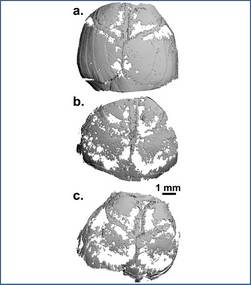
In America, more than 5,000 bones will break today due to osteoporosis.
For Paula Stern, PhD, professor and vice-chair of molecular pharmacology and biological chemistry, determining how the body builds and destroys its infrastructure at a cellular level has been a career-long pursuit.
“My interest lies in the mechanisms by which systemic hormones, local factors, physical forces, and disease processes affect the formation and breakdown of bone,” Stern said. “Early on, we developed models to measure the active form of vitamin D and showed that there were changes associated with disorders of calcium metabolism.”
Today, Stern’s lab is focused on osteoporosis, sex-specific differences, and cancer metastases.
Bone breakdown has its most visible presence in osteoporosis, a disease that occurs when a person loses too much bone, makes too little, or both. As a result, bones become weak and can break. By 2020, the National Osteoporosis Foundation (NOF) predicts that half of all Americans older than 50 will suffer from the disease. This year alone, the organization estimates that osteoporosis will result in 2 million broken bones in America.
New Discoveries, New Hope
Although most of the therapeutic treatments for osteoporosis work to prevent bone breakdown, parathyroid hormone treatment given intermittently – a once a day injection – has been proven to actually build tissue. But parathyroid hormone is a complicated molecule that when produced by a tumor in a continuous manner will actually break bone down.
“While we’ve been looking at some signaling pathways and the genes they affect in an attempt to identify the mechanisms that exist for destroying bone, on the other side of the equation we’ve seen progress in determining the signaling involved in the anabolic effects of parathyroid hormones that build it,” Stern said.
Honored as the Lawrence G. Raisz Memorial Lecturer at the NOF International Symposium on Osteoporosis in late April, Stern points out that many of her basic science studies have clinical correlates.
“Osteoporosis is far more complex than just drinking a glass of milk a day, it is a cellular disorder in which there is loss of bone mineral and matrix – collagen and other proteins,” she said. “Bone is a dynamic tissue, and is continuously being broken down and reformed. When formation does not keep pace with breakdown, osteoporosis is the result.”

Throughout her nearly five decades at the medical school, Stern has also investigated the differences in tissue between men and women. While males develop more bone and females are more susceptible to bone loss, both sexes can develop osteoporosis.
“Our studies so far show that there are in fact differences in the responses of osteoclast cells – the cells that cause bone breakdown – and this has provided an opening to do further investigation,” said Stern, who is studying the topic with a grant from the Women’s Health Science Program. “We are investigating the differences in bone cells in terms of their responses to treatments because we think this is an area that really needs more exploration.”
Varied Research
Working on a number of projects, Stern recently collaborated on research published in the Journal of Bone Joint Surgery and Journal of Biological Chemistry on atypical femoral fractures and a protein involved in calcium transport, respectively. She’s also recently authored a review article on how vitamin D works on bone in Endocrinology and Metabolism Clinics of North America and composed a book chapter on thyroid hormone and bone.
Her pursuit of determining what happens when cancer metastasizes in bone has never wavered. Different from cancer that starts in the bone, cancer that leads to bone metastasis has spread from another source. With treatment but no cure, scientists are just beginning to understand what happens in the bone to prompt this process.
“We are trying to uncover why bone is a target tissue for some cancers, what effect bone metastasis has, and what therapies might be useful for that treatment,” Stern said. “When I started my scientific career, there were no treatments for many of these diseases, like osteoporosis, and today we near a time when we may not only be able to build bone, but reverse bone loss. The thing that continues to drive me is that there are so many unanswered questions, so many unexpected findings, and there is immense enjoyment of working with others to discover new things.”






